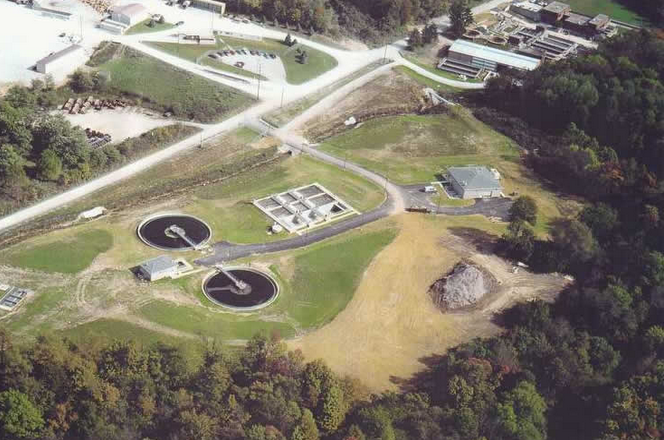WASTE WATER
The City of Greencastle owns and operates a wastewater collections system and treatment facility that processes and treats sanitary waste for Greencastle and FilLmore Indiana.
TREAMENT SUMMARY
The City of Greencastle owns and operates a wastewater collections system and treatment facility that processes treats sanitary waste for Greencastle and the town of Fillmore Indiana.
The wastewater facility has a design capacity of 2.8 MGD with a peak flow capacity of 16 MGD. The treatment consists of mechanical processes and utilizes the Vertical Loop Reactor, which is a modification of the standard activated sludge process to create a natural biological environment that treats the wastewater on a continuous flow-through basis, to treat the wastewater to an environmentally safe level, with the treated effluent being discharged into Big Walnut Creek.
PLANT HISTORY
It is believed that the original wastewater treatment plant was built in the 1930s. The original plant was expanded and upgraded during major projects in 1949, 1962, and 1994. In the late 1990s the City of Greencastle began to have concerns the existing plant’s ability to meet the future needs because of the City’s growth rate, and the need to plan for the future. Since the existing facility was operating at 86% of its design capacity of 1.8 MGD it became apparent that the City needed to make plans for the wastewater plants to be prepared for future needs and the continuation of the growth not only for the City but also the surrounding area.
Key Goals
To receive and treat all wastewater for the City of Greencastle to a level that it maintains all permit required standards with the Indiana Department of Environmental Management, Permit Number IN0021032. The Wastewater facility strives to achieve the highest water quality possible so that the effluent discharge is of benefit, not detriment to the environment
Wastewater Facilities Description
The City of Greencastle Wastewater Treatment Facility is made up of three (3) major unit processes components:
- The Wastewater Collections System
- Liquid Treatment processes
- Residuals Treatment Processes
WASTE WATER PLANT
LIQUID TREATMENT
Headwork’s. (Beginning Processes)
Raw wastewater is screened with two mechanical fine screens, with a rated flow of 8 MGD each. The downstream grit head-cells remove the heavy material which is then pumped to the grit classifier which provides grit washing prior to dewatering. All grit material is disposed of in an authorized landfill.
Secondary Treatment
Effluent from the grit head cells along with the addition of the return sludge and flows by gravity to the Vertical Loop Reactor are Process for biological treatment of the wastewater. This process creates an aerobic environment where a natural type bacteria (activated sludge) utilize, the organics in wastewater as a food source and reduces the pollutants in the wastewater by more than 99% overall.
Final Clarification
The Mixed Liquor, which is a combination of bacteria or bio-mass, and the treated wastewater, flows by gravity to the Final Clarifiers. The Final Clarifiers allow the bio-mass to settle to the bottom of the clarifiers and the treated wastewater or effluent overflow V-notched weirs by gravity, and flow to the Ultraviolet Disinfection System.
Ultraviolet Disinfection System
The UV System or disinfection process is used in the treatment process to protect the water quality of the receiving stream for the downstream users. The receiving stream for the plant effluent in Greencastle is Big Walnut Creek.
Failure to disinfect the treated plant effluent would allow the receiving stream to become infected with disease-causing pathogenic organisms, which can limit the use of the receiving stream as a source for public water supply, swimming, bathing, aquatic and animal life use, and irrigation of crops.
Post Aeration
The purpose of post aeration is to increase the dissolved oxygen content of the treated effluent prior to discharge to the receiving stream, which is Big Walnut Creek for the Greencastle facility.
As part of the final treatment process, air is introduced into the disinfected effluent in a post aeration tank and flows to a cascade aerator prior to discharge. The addition of air or oxygen encourages the growth of aerobic bacteria and helps the receiving stream’s natural purification.
Residuals Treatment
The residuals treatment process deals with excess activated sludge, screening, and grit materials removed from the other treatment process areas at the plant.
Screening and grit from the headwork’s process are transported to landfill for disposal
The excess activated sludge is treated in aerobic digesters. The digester process is another biologic form of treatment. It reduces the activated sludge by 40-50% when it is aerated for a period of 18-21 days.
After the sludge has been digested it is removed, thickened and sent to a belt press for dewatering. The sludge cake concentration after dewatering is 17- 18%, the material is then put in a windrow building were it is turned over several times during over @ 7-10 day period; this allow the cake solids to increase to 25-30%. The sludge is then removed and sent to landfill for disposal.
Thank You for visiting us.
Oscar King
Senior Operator – Collections
File A Complaint
Copyright © 2023 The City of Greencastle |
We trust
Distinct
with our Website because of their Unlimited Support,
Client Testimonials, and
Website Maintenance Checklist.

